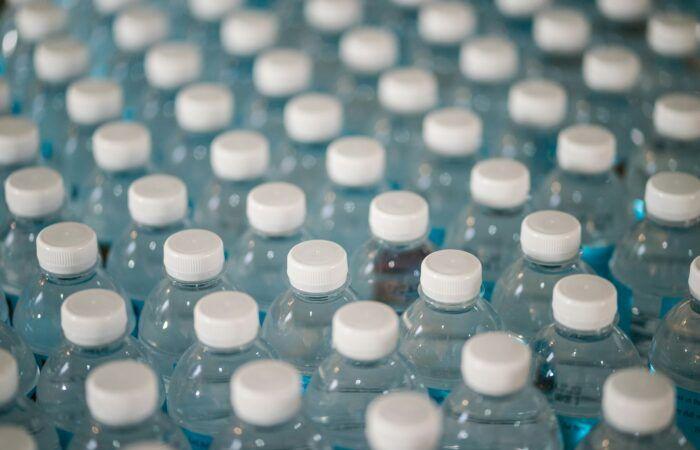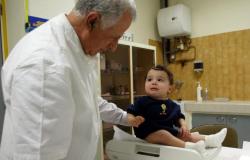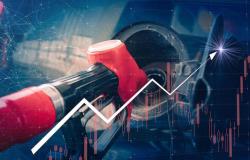The true – polluted – nature of plastic bottled water
In view of the messages marketed by advertisements, bottled water – flowing directly from the mountains – would be more natural and better for your health than tap water. Drawn from deep underground aquifers, these natural spring and mineral waters would be less polluted, thus allowing manufacturers to sell them on average 100 times more expensive than tap water.
Is bottled water better for your health? Nothing is less certain. Each year, several studies show new aspects of the contamination of bottled water: 78% of bottled mineral waters analyzed in 2022 by the Agir pour l’Environnement association were contaminated by microplastics.[1]. These contaminations come from the packaging, whether the bottle or the cap, but also from the treatment processes that the water undergoes before bottling. In addition to microplastics (particles less than 5 millimeters), nanoplastics (less than one micrometer) are now added: according to the study carried out by researchers at Columbia University [2], each liter of bottled water contains hundreds of thousands of plastic particles, including 90% nanoplastics. A rate which represents up to 100 times more microparticles than those recorded until now.
In addition to this plastic pollution of bottled water, there is microbiological contamination. A report from the interministerial general inspection of the social sector (IGAS) delivered in 2022 and publicly revealed by an investigation by France Info and Le Monde [3]estimates that at least 30% of French spring and mineral water brands use non-compliant treatments to hide the presence of microbiological and chemical contamination (pesticide residues, PFAS, etc.). An ANSES note, submitted to the government in October 2023, reports these regular contaminations on numerous wells of the Nestlé group, and considers that the non-compliances detected “should not lead to the production of bottled water”. Clearly, contaminated sources should no longer be exploited to produce natural mineral water.
Significant health and environmental costs
In its very principle, water bottling is an environmental aberration, on several levels:
- For some private companies, this involvesmonopolize common property to the detriment of vital uses (drinking water, water intended to produce our food, water allowing the survival of biodiversity). In times of drought and restrictions, manufacturers continue to happily pump groundwater, without any restrictions.
- This common natural resource is then packaged in plastic, which will, at best, be recycled with a loss of material and emissions of plastic particles, or at worst, burned, buried or thrown into nature. This plastic packaging contributes to immediately contaminating this water, through a process of degradation upon contact with water.
- Finally, it is about transport a local resource hundreds or thousands of kilometers (via global exports) with considerable greenhouse gas emissions. According to ADEME, tap water emits 2,000 times less CO2 than bottled water. [4].
In addition to these environmental costs, there are health costs: exposure to microplastics is suspected of having numerous long-term effects (cancers, diabetes, neurological, respiratory and cardiovascular problems, etc.). Although knowledge of the impact of nanoplastics on health is still limited, researchers nevertheless point out that these particles are small enough to penetrate the blood system and end up in organs. If additional and more precise studies must be carried out to determine the links between micro and nanoplastic pollution and human health, the first results are already very worrying, and the precautionary principle should prevail.
And all this, for what? We must not forget that bottled water is above all a real financial windfall for manufacturers. 14.7 billion bottles are sold in France each year, all drinks combined, or around 220 per French person. [4]. Water represents the content of 8.4 billion of these bottlesor nearly 60% of them [5]. In total, according to IGAS, bottled water represents a colossal market of 2 billion euros each year.
What alternatives to plastic bottled water?
What does the regulation say?
The AGEC law of 2020 sets a target of reducing plastic bottles by 50% between 2018 and 2030, which requires going from 14.6 to 7.3 billion units marketed. This law also provides for the ban on single-use plastics by 2040.
Beware of the false good ideas that are multiplying! New single-use packaging is emerging on the mineral water and spring water market, under the guise of “deplasticization” of practices: TetraPakⓇ packaging or even aluminum cans for example. The environmental impact of this packaging is just as problematic as that of plastic, due to the waste of resources they represent, the energy they require (for their production, their management, their possible recycling, etc.), and , sometimes, eternal pollutants necessary for their manufacture. The real concern lies in the single use of this packaging, thrown away after a single use.
The only viable alternative from a health and environmental perspective: a good quality tap water. Although it is present throughout the country, tap water is not free from contamination. Freed from plastic contamination from the plastic bottles themselves, tap water is also plagued by chemical contamination (presence of chemical pollutants, pesticide residues and PFAS, as with water in plastic bottles). According to a France Info survey in September 2024 [6]out of 89 tap water samples, 43% contained PFAS. Unlike bottled water, tap water however has the merit of being controlled on more than 70 parameters, in complete transparency, by Regional Health Agencies, and not by companies whose sole objective is to make a profit, whatever the cost.
Zero Waste France’s requests
To combat plastic pollution from water bottles
In order to move away from single-use plastic by 2040, as provided by the AGEC law, it is necessary to specify the intermediate steps and gradually force manufacturers to reduce their plastic production at the source. For this, Zero Waste France offers to:
- quickly implement the first bans, to begin to reduce plastic pollution linked to water bottling and change consumption practices of single-use bottles. The ban on the marketing on the French market of small plastic water bottles (less than 50 cl), currently under debate, goes in particular in this direction;
- gradually ban single use and transfer to other materials, to limit the waste of new resources, particularly in the paper and cardboard, aluminum and “bio-sourced” alternatives sectors.
For a fairer distribution and quality of water
For tap water to undoubtedly become the best alternative to water in plastic bottles, it is essential to pursue an ambitious public water policywith adequate financial means. Despite the launch in 2023 by the government of an Action Plan for resilient and concerted water management, the 53 actions listed are far from being sufficient to resolve both the issues of preservation, distribution and distribution. improvement of water quality.
Concerning the quality of tap water, Zero Waste France insists on the need to take measures to:
- strengthen water quality monitoring standards and methods, as requested by our partners Surfrider Fondation Europe and European Environmental Bureau;
- no longer cover up non-compliance with the law by manufacturers – as was the case in the Nestlé-Waters affair, according to revelations from Le Monde and France Info;
- ban PFAS, or “eternal pollutants”, as well as bisphenols, responsible for part of this water pollution;
- prepare a necessary transformation of the extensive agricultural model based on the use of pesticides, to reduce chemical pollution of water.
In general, several associations, including Zero Waste France, called in a June 2023 forum [7] to rethink our uses of water and its distribution in the light of new realities: droughts, floods, multiple pollutions, etc. A real subject of social justice, it is central to implement an ambitious policy allowing a fair and sustainable distribution of water resources. Firstly, ensure that exemptions from restrictions on water use are no longer granted for non-essential uses (swimming pools, golf courses, etc.) or which do not allow the populations to be directly fed. More generally, it is a question of choosing between a model of intensive and destructive agriculture (excessive withdrawals and mega-basins) and peasant agriculture, nourishing and efficient in water.
Finally, as the fifth session of negotiations for the international treaty against plastic pollution approaches, Zero Waste France is a signatory, with around a hundred organizations, of acall to halt the expansion of single-use plastics, particularly plastic bottleswhich in addition to constituting a major source of pollution, constitute a real obstacle to access to water for all. Indeed, according to a United Nations University study, the bottled water market is growing exponentially – 73% over the last decade. However, this expansion, in addition to the plastic pollution generated, directly compromises efforts to guarantee universal access to drinking water and diverts the investments necessary for the development of public water supply systems.
Read the call (in English)
Sources :
[1] Exclusive study: 78% of bottled water analyzed contaminated by microplastics | Acting for the Environment, July 20, 2022
[2] Rapid single-particle chemical imaging of nanoplastics by SRS microscopy, PNAS, janvier 2024
[3] FRANCEINFO INVESTIGATION, Several bottled water producers illegally filtered their water to hide contamination, January 30, 2024
[4] Instructions for reuse and recycling of beverage bottles, ADEME, 2021.
[5] Bottled water | CO₂ impact, ADEME
[6] INVESTIGATION. Tap water: the map of France for contamination with eternal pollutants, France Info, September 19, 2024
[7] TRIBUNE. “Drink or waste, you have to choose”: faced with global warming, environmental associations are calling for “urgently rethinking our water uses”, France Info, June 5, 2023






